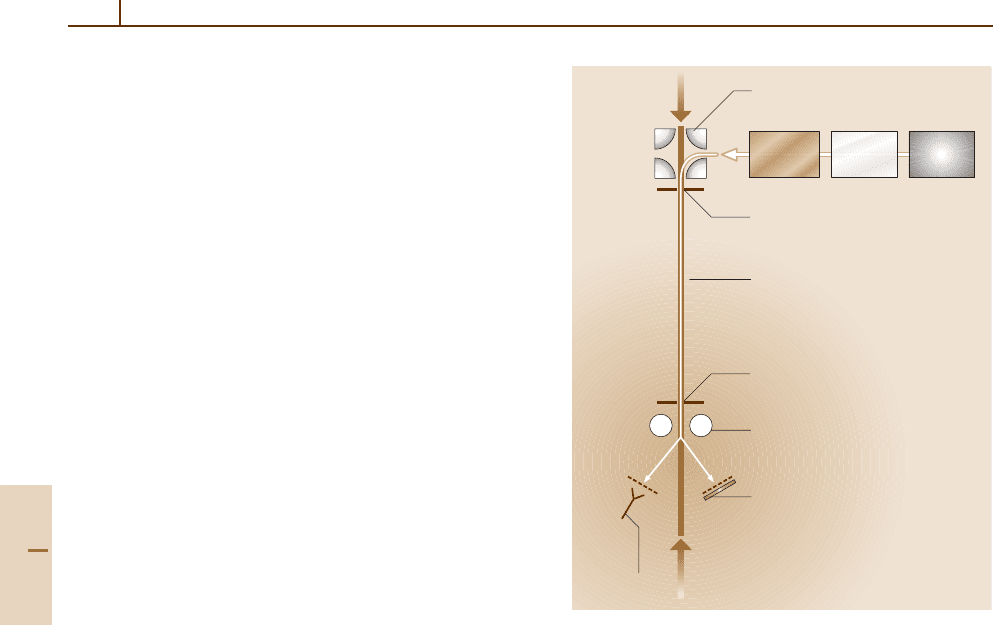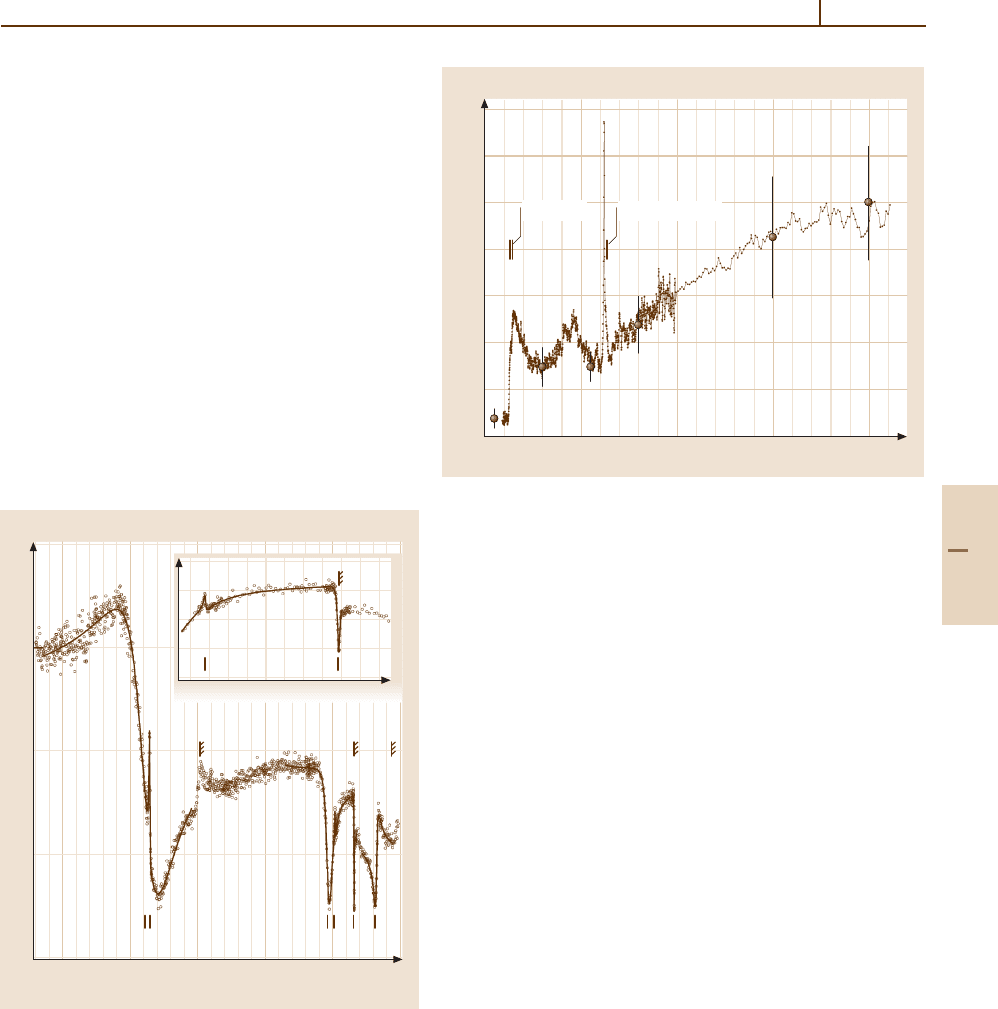Drake G.W.F. (editor) Handbook of Atomic, Molecular, and Optical Physics
Подождите немного. Документ загружается.


Collisional Broadening of Spectral Lines 59.5 One-Perturber Approximation 887
Adiabatic states of the diatomic molecule formed by the
emitter-perturber system are considered in which the to-
tal spin is assumed to be decoupled from the total orbital
angular momentum of the electrons. The coupling be-
tween rotational and electronic angular momentum can
also be neglected, because typically, contributions to the
lineprofilecomefrom0≤l
j
400, whereas Λ
j
2.
Therefore, transitions take place between channels de-
fined by
Γ
j
= Λ
j
L
j
SL
j
, j = i, f , (59.118)
where the unperturbed emitter in state j has quan-
tum numbers L
j
S, the quantum number Λ
j
represents
the projection of the orbital angular momentum on the
internuclear axis, and (59.100) is replaced by
Ψ
J
(
r, R
)
= O
j
ψ
j
(
r; R
)
φ
k
j
, k
j
0
; R
,
(59.119)
where k
j
= k
j
0
and ψ
j
(
r; R
)
is the wave function for
molecular state Λ
j
. In (59.119), the only molecular
states retained are those that correlate with emitter states
i and f . The scattering is described by
d
2
dR
2
−
l
j
l
j
+1
R
2
−
2z
R
−
2µ
2
V
Λ
j
(
R
)
+k
2
j
× F
j
(
R
)
= 0 ,
(59.120)
where k
j
= k
j
0
and
F
j
(
R
)
= P
v
j
l
j
(
R
)
or
F
j
(
R
)
≡ F
Γ
j
,Γ
j
; R
= F
k
i
l
i
(
R
)
(59.121)
for vibrational or free states, respectively, and V
Λ
j
(
R
)
is the potential energy of state Λ
j
. Free–free transitions
always contribute to the line profile, but bound-free and
free-bound transitions only contribute on the red and
blue wings, respectively. On using (59.82), (59.99), and
(59.109),
∆ω = ε
i
−ε
f
,andε
j
becomes the energy of
bound state j with vibrational quantum number v
j
when
ε
j
< 0 . If
G
Γ, ε
i
,ε
f
≡
∞
0
F
∗
i
(
R
)
¯
∆
(
R
)
F
f
(
R
)
dR
2
(59.122)
[cf. (59.107)], where
¯
∆
(
R
)
=−q
ψ
∗
i
(
r; R
)
r ψ
f
(
r; R
)
dr
(59.123)
is the dipole moment, then using (59.119)), the free–free
contribution is given by
I
0
(
ω
)
=
N
2
Γ
i
Γ
f
u
Λ
i
δ
l
i
l
f
(
2l
i
+1
)
×
∞
0
f(v)
v
dv G(Γ, ε
i
,ε
f
),
(59.124)
where ε
i
=
1
2
µv
2
,andu
Λ
i
is the relative weight of
state Λ
i
[cf. Eqs. (59.106)–(59.108)]. The bound-free
contribution is
I
1
(
ω
)
=
N
2
Γ
i
Γ
f
u
Λ
i
δ
l
i
l
f
(
2l
i
+1
)
×
i
g
(
ε
i
)
G
Γ, ε
i
,ε
f
(59.125)
and the free–bound contribution is
I
2
(
ω
)
=
1
2
N
Γ
i
Γ
f
u
Λ
i
δ
l
i
l
f
(
2l
i
+1
)
exp
−
∆ω
k
B
T
×
f
g
ε
f
G
Γ, ε
i
,ε
f
,
(59.126)
where
g(ε) = 2π
µ
2
f(v)
v
2
= 8π
2
µ
2
µ
2πk
B
T
3/2
exp
−
ε
k
B
T
,
(59.127)
on using (59.21) with ε =
1
2
µv
2
. The full line profile is
then given by (59.124)–(59.126), so that
I
(
ω
)
=
2
j=0
I
j
(
ω
)
.
(59.128)
The satellite features that are often seen in line wings
arise because turning points in the difference potential
V
Λ
i
(
R
)
−V
Λ
f
(
R
)
produce a phenomenon analogous
to the formation of rainbows in scattering theory. The
JWKB approximation is often used for the functions
F
k
j
l
j
(
R
)
, and can be shown to lead to the correct
static limit in which transitions take place at fixed
values of R called ‘Condon points’, i.e., the Franck–
Condon principle is valid. Further details are given
in [59.9,10, 24–26].
Part D 59.5

888 Part D Scattering Theory
59.6 Unified Theories and Conclusions
The pressure broadening of spectral lines is in general
a time-dependent many-body problem and as such can-
not be solved exactly. After all, even the problem of two
free electrons scattered by a proton is still a subject of
active research. There is no practical theory that leads to
the full static profile in the limit of high density (or low
temperature) and to the full impact profile in the limit
of low density (or high temperature). As with so many
problems in physics, it is the intermediate problem that is
intractable because no particular feature can be singled
out as providing a weak perturbation on a known phys-
ical situation. However, much progress has been made
over the last thirty years in developing theories that take
into account many of the key features of the intermedi-
ate problem and they are often successful in predicting
line profiles for practical applications [59.8–10, 24–26].
More recently, time-dependent many-body problems
have been tackled using computer-oriented approaches
that invoke Monte Carlo and other simulation meth-
ods to study line broadening in dense, high-temperature
plasmas, see for example [59.27]. In this chapter, the
emphasis has been on aspects of the subject that relate
directly to electron-atom and low-energy atom–atom
scattering. Many experts in the fields of electron–atom
and atom–atom collisions are still not exploiting the di-
rect applicability of their work to line broadening. It
is hoped that this contribution will encourage more re-
search workers to study these fascinating problems that
not only provide links with plasma physics and in par-
ticular with the physics of fusion plasmas, but also with
a quite distinct body of laboratory-based experimental
data.
References
59.1 J. R. Fuhr, W. L. Wiese, L. J. Roszman: Bibliogra-
phy on Atomic Line Shapes and Shifts, Special
Publication 366 (National Bureau of Standards,
Washington, DC. 1972)
59.2 J. R. Fuhr, L. J. Roszman, W. L. Wiese: Bibliogra-
phy on Atomic Line Shapes and Shifts, Special
Publication 366 (National Bureau of Standards,
Washington, DC. 1974), Supplement 1
59.3 J. R. Fuhr, G. A. Martin, B. J. Specht: Bibliogra-
phy on Atomic Line Shapes and Shifts, Special
Publication 366 (National Bureau of Standards,
Washington, DC. 1974), Supplement 2
59.4 J. R. Fuhr, B. M. Miller, G. A. Martin: Bibliogra-
phy on Atomic Line Shapes and Shifts, Special
Publication 366 (National Bureau of Standards,
Washington, DC. 1978), Supplement 3
59.5 J. R. Fuhr, A. Lesage: Bibliography on Atomic
Line Shapes and Shifts, Special Publication 366
(National Institute of Standards and Technology,
Washington, DC. 1992), Supplement 4
59.6 A.Lesage,J.R.Fuhr:Bibliography on Atomic Line
Shapes and Shifts (Observatoire de Paris, Meudon
1998), Supplement 5
59.7 http://www.physics.nist.gov/PhysRefData
</Redirect/www.physics.nist.gov/PhysRefData>
59.8 H. R. Griem: Spectral Line Broadening in Plasmas
(Academic, New York 1974)
59.9 G. Peach: Adv. Phys. 30,367(1981)
59.10 N. Allard, J. R. Kielkopf: Rev. Mod. Phys. 54, 1103
(1982)
59.11 A. Ben-Reuven: Phys. Rev. 145, 7 (1966)
59.12 A. Ben-Reuven: Adv. Atom. Molec. Phys. 5,201
(1969)
59.13 R. Ciuryto, A. S. Pine: J. Quant. Spectrosc. Radiat.
Transfer 67, 375 (2000)
59.14 E. L. Lewis: Phys. Rep. 58,1(1980)
59.15 S. Sahal-Bréchot: Astron. & Astrophys. 1, 91 (1969)
59.16 S. Sahal-Bréchot: Astron. & Astrophys. 2, 322 (1969)
59.17 M. S. Dimitrijevi
´
c, N. Konjevi
´
c: J. Quant. Spectrosc.
Radiat. Transfer 24,451(1980)
59.18 N. Konjevi
´
c: Phys. Rep. 316, 339 (1999)
59.19 G. K. Oertel, L. P. Shomo: Astrophys. J. Suppl. 16,175
(1969)
59.20 M. J. Seaton: J. Phys. B 21, 3033 (1988)
59.21 M. J. Seaton: J. Phys. B 22, 3603 (1989)
59.22 V. I. Kogan, V. S. Lisitsa, G. V. Sholin: Rev. Plasma
Phys. 13,261(1987)
59.23 P. J. Leo, G. Peach, I. B. Whittingham: J. Phys. B 28,
591 (1995)
59.24 J. Szudy, W. E. Baylis: J. Quant. Spectrosc. Radiat.
Transfer 15,641(1975)
59.25 J. Szudy, W. E. Baylis: J. Quant. Spectrosc. Radiat.
Transfer 17, 269 (1977)
59.26 J. Szudy, W. E. Baylis: Phys. Rep. 266, 127 (1996)
59.27 A. Calisti, L. Godbert, R. Stamm, B. Talin: J. Quant.
Spectrosc. Radiat. Transfer 51, 59 (1994)
Part D 59

889
Scattering
Part E
Part E Scattering Experiments
60 Photodetachment
David J. Pegg, Knoxville, USA
61 Photon–Atom Interactions: Low Energy
Denise Caldwell, Arlington, USA
Manfred O. Krause, Oak Ridge, USA
62 Photon–Atom Interactions:
Intermediate Energies
Bernd Crasemann, Eugene, USA
63 Electron–Atom and Electron–Molecule Collisions
Sandor Trajmar, Redwood City, USA
William J. McConkey, Windsor, Canada
Isik Kanik, Pasadena, USA
64 Ion–Atom Scattering Experiments:
Low Energy
Ronald Phaneuf, Reno, USA
65 Ion–Atom Collisions – High Energy
Lew Cocke, Manhattan, USA
Michael Schulz, Rolla, USA
66 Reactive Scattering
Arthur G. Suits, Stony Brook, USA
Yuan T. Lee, Taipei, Taiwan
67 Ion–Molecule Reactions
James M. Farrar, Rochester, USA

891
Photodetachm
60. Photodetachment
Investigations of photon-ion interactions have
grown rapidly over the past few decades due
primarily to the increased availability of laser
and synchrotron light sources. At photon ener-
gies below about 1 keV the dominant radiative
process is the electric dipole induced pho-
toelectric effect. In the gaseous phase the
photoelectric effect is referred to as either
photoionization (atoms and positive ions) or
photodetachment (negative ions). This chapter
reviews developments in the field of pho-
todetachment that have taken place over the
past decade. The focus will be on accelerator-
based investigations of the photodetachment
of atomic negative ions. The monographs of
Massey [60.1]andSmirnov [60.2] offer a good
introduction to the subject of negative ions.
Recentreviewsofnegativeionsandpho-
todetachment include those of Bates [60.3],
Buckman and Clark [60.4], Blondel [60.5], An-
60.1 Negative Ions ...................................... 891
60.2 Photodetachment................................ 892
60.2.1 Threshold Behavior ................... 892
60.2.2 Resonance Structure .................. 892
60.2.3 Higher Order Processes............... 893
60.3 Experimental Procedures...................... 893
60.3.1 Production of Negative Ions........ 893
60.3.2 Interacting Beams ..................... 893
60.3.3 Light Sources ............................ 894
60.3.4 Detection Schemes .................... 895
60.4 Results ............................................... 895
60.4.1 Threshold Measurements ........... 895
60.4.2 Resonance Parameters............... 896
60.4.3 Lifetimes of Metastable Negative
Ions......................................... 897
60.4.4 Multielectron Detachment .......... 898
References .................................................. 898
dersen [60.6], Andersen et al. [60.7]andBilodeau
and Haugen [60.8].
60.1 Negative Ions
Interest in negative ions stems from the fact that their
structure and dynamics are qualitatively different from
those of isoelectronic atoms and positive ions. This can
be traced to the nature of the force that binds the out-
ermost electron. In the case of atoms and positive ions,
the outermost electron moves asymptotically in the long
range Coulomb field of the positively charged core.
The relatively strong 1/r potential is able to support
an infinite spectrum of bound states that converge on
the ionization limit. In contrast, the outermost electron
in a negative ion experiences the short-range induced-
dipole field of the atomic core. The relatively weak 1/r
4
polarization potential is shallow and typically can only
support a single bound state. The weakness of the bind-
ing is reflected in the magnitudes of electron affinities
of atoms, which are numerically equal to the binding
energies of the outermost electron in the corresponding
negative ion. Electron affinities are typically an order
of magnitude smaller than the ionization energies of
atoms. Excited bound states of negative ions are rare.
With the possible exception of Os
−
, all such states that
exist have the same configuration, and therefore parity,
as the ground state. A rich spectrum of unbound excited
states, however, are associated with most ions. These
discrete states are embedded in the continua lying above
the first detachment limit.
Electron correlation plays an important role in de-
termining the structure and dynamics of many-electron
systems [60.9]. Weakly bound systems such as neg-
ative ions are ideally suited for investigations of the
effects of correlation. As a result of the more effi-
cient shielding of the nucleus by the atomic core, the
electron–electron interactions become relatively more
important than the electron-nucleus interaction in neg-
ative ions. The goal of photodetachment experiments
is to measure, in high resolution, correlation-sensitive
quantities such as electron affinities and the ener-
gies and widths of resonant states. These quantities
Part E 60

892 Part E Scattering Experiment
provide sensitive tests of the ability of theorists to in-
corporate electron correlation into their calculations.
The stimulating interplay between experiment and
theory continues to help elucidate the role of many-
electron effects in the structure and dynamics of atomic
systems.
60.2 Photodetachment
Essentially all information about the structure and
dynamics of negative ions comes from controlled ex-
periments in which electrons are detached from the
ions when they interact with photons or other par-
ticles. Photodetachment is the preferred method of
studying negative ion structure and dynamics since
the energy resolution associated with such measure-
ments is typically much higher than that attainable
in any particle-induced detachment process. Generally,
one or more electrons are detached from a nega-
tive ion following the absorption of one or more
photons in the photodetachment process. Most measure-
ments to date, however, involve the simplest process
of single electron detachment following single pho-
ton absorption. Cross sections for this process start
at zero at threshold, rise to a maximum a few eV
above threshold and then decrease monotonically. Pho-
todetachment cross sections at their maximum have
a typical magnitude of ≈ 10–100 Mb. Threshold be-
havior and resonance structure in detachment cross
sections are of particular interest since they both
involve a high degree of correlation between the
electrons.
60.2.1 Threshold Behavior
Cross sections for photodetachment are zero at thresh-
old, in contrast to the finite value characteristic of
photoionization cross sections. The threshold behavior
is determined by the dynamics of two particles in the
final continuum state. The Wigner law [60.10] governs
the energy dependence of the near-threshold cross sec-
tion for the photodetachment of a single electron from
an atomic negative ion. The Wigner law can be written
as
σ = Ak
2l+1
= B(E − E
t
)
l+1/2
, (60.1)
where k represents the wavenumber of the detached
electron, (E − E
t
) is the excess energy of the elec-
tron above threshold and l is the smallest value of
the orbital angular momentum quantum number. As
a result of the electric dipole selection rules, the de-
tached electron is represented, in general, by two
partial waves with l = l
0
+ 1andl
0
− 1, where l
0
is the angular momentum of the bound electron in
the negative ion prior to detachment. Wigner demon-
strated that for a two-body final state the near-threshold
cross section depends only on the dominant long-
range interaction between the two product particles.
In the case of photodetachment involving electrons
with l > 0, this contribution arises from the centrifugal
force. Shorter-range interactions, such as the polariza-
tion force, will not change the form of the threshold
behavior but they will limit the range of validity of
the Wigner law. There is no a priori way of deter-
mining the range of validity of the Wigner law in
any particular experiment. It depends on the strengths
of short-range interactions. Measured threshold data
is usually fit to the Wigner law in order to deter-
mine the threshold energy. In principle, it is possible
to extend the range of the fit beyond that of the
Wigner law. O’Malley [60.11], for example, considered
the effects of multipole forces on threshold behavior.
O’Malley’s formalism, however, does not treat polar-
ization explicitly. This is, however, accounted for in
the modified effective range theory of Watanabe and
Greene [60.12]. Recently, Sandstroem et al. [60.13]
have used a modified effective range theory to fit pho-
todetachment data taken at excited state thresholds of
the alkali-metal atoms, Li and K. In these cases the
dipole polarizability is very high and consequently the
range of validity of the Wigner law is correspondingly
small.
60.2.2 Resonance Structure
Negative ion resonances correspond to states in which
an electron and an atom are transiently associated.
Such states are the subject of a review by Buckman
and Clark [60.4]. In photodetachment they arise when
more than one electron, or a core electron, is excited.
These unbound discrete states are embedded in the con-
tinua above the first detachment limit and are therefore
subject to decay via the spontaneous process of au-
todetachment. The allowed autodetachment process is
induced by the relatively strong electrostatic interaction
Part E 60.2

Photodetachment 60.3 Experimental Procedures 893
between the outermost electrons. This process causes
discrete continuum states to be very short lived. If the
selection rules on the allowed Coulomb-induced autode-
tachment process are violated, however, the state may
live much longer. Metastable states eventually decay
via autodetachment processes induced by the weaker
magnetic interactions. The He
−
ion is the prototypical
metastable negative ion. It is formed in the spin-aligned
1s2s2p
4
P
0
state when an electron attaches itself to
a He atom in the metastable 1s2s
3
S . It is bound by
77.516 meV [60.14]. The decay of a discrete state in the
continuum by autodetachment is manifested as a res-
onance structure in the detachment cross section. The
shape of a resonance is determined by the interference
between the two pathways for reaching the same final
continuum state: direct detachment and detachment via
the discrete state embedded in the continuum. A reso-
nance can be parametrized by fitting it to a Fano [60.15]
or Shore profile [60.16]. The energy and width of
the discrete continuum state are extracted from the
fit.
60.2.3 Higher Order Processes
With the advent of high power, pulsed lasers it became
possible to observe multiphoton detachment. In this pro-
cess a single electron is ejected following the absorption
of two or more photons. Early work in this area has
been reviewed by Crance [60.17], Davidson [60.18]and
Blondel [60.5]. More recently, Haugen and coworkers
have used two photon E1 transitions to determine fine
structure splittings in the ground state of negative ions
and to measure the binding energies of excited states of
negative ions that have the same parity as the ground
state. Bilodeau and Haugen [60.8]havereviewedthese
measurements.
Multielectron detachment involves the detachment
of two or more electrons following the absorption of
a single photon. This process, which appears to be
initiated by the detachment of an inner shell electron,
requires photons with energies higher than can be gen-
erated by lasers. Such measurements can be performed
at synchrotron radiation sites.
60.3 Experimental Procedures
60.3.1 Production of Negative Ions
Negative ions are created in exoergic attachment pro-
cesses when an electron is captured by an atom or
molecule. These quantum systems are weakly bound
with diffuse outer orbitals. As a consequence, they are
easily destroyed in collisions with other particles. Due
to their fragility they are rarely observed in bulk matter.
The production of negative ions with a density suffi-
ciently high for spectroscopic studies poses a challenge
to the experimentalist since processes involved in their
creation must compete with more probable destruction
processes. The most versatile source of production of
negative ions for accelerator-based experiments is the
Cs sputter ion source [60.19]. This source has been used
to generate a wide variety of atomic, molecular, and
cluster negative ions.
Negative ions can be produced and maintained in
ion traps [60.20]. In this case, the ions are produced
inside the trap by electron-induced dissociative attach-
ment collisions and photodetachment is investigated
by monitoring the depletion of the negative ions. The
most commonly used source for spectroscopic studies
of negative ions is, however, a beam produced by an
accelerator. In an accelerator-based apparatus the ions
are extracted from the ion source and focused to form
a collimated beam that is accelerated to a desired en-
ergy, typically 1–10 keV. Mass analysis of the ions is
used to produce an elementally and isotopically pure
beam that is essentially mono–energetic and unidirec-
tional. The directed particles then drift to the interaction
region through a beam line that is maintained at low
pressure to minimize destructive collisions between the
ions and the residual gas. Recently, negative ions have
been injected into storage rings. In this case the ions
make repeated passes through the interaction region.
The enhanced luminosity associated with multiple-pass
experiments makes it possible to investigate relatively
rare processes that would be impossible in single-pass
experiments.
60.3.2 Interacting Beams
The well-defined spatial dimensions of an ion beam
readily permit an efficient overlap with a beam of pho-
tons. The two interacting beams are most often mated in
either crossed or collinear beam geometries. The choice
of geometry is typically determined by the types of par-
ticles to be detected, the detection geometry to be used,
and the level of sensitivity and resolution required in
Part E 60.3

894 Part E Scattering Experiment
the experiment. The crossed beam arrangement is best
suited for spectroscopic studies of the photoelectrons
ejected following photodetachment, since the electrons
can most easily be collected from a spatially well defined
interaction region. In a collinear beam arrangement it is
better to detect the residual heavy particles produced
in the photodetachment process since they all travel in
the same direction, the direction of motion of the ion
beam, and can be collected with high efficiency. Both
the sensitivity and energy resolution attainable using
a collinear beam apparatus are typically much higher
than for a crossed beam apparatus. Nowadays, most
experiments employ an apparatus in which the photon
and ions are collinearly merged and the present chap-
ter will focus on this arrangement. Figure 60.1 shows
a typical collinear beam apparatus that was designed
by Hanstorp [60.21]. The signal is enhanced when the
photon and ion beams are collinearly merged due to
the extended interaction region and the high collection
and detection efficiencies of the heavy residual par-
ticles. The major source of background noise in collinear
beam experiments is associated with the production of
atoms or positive ions by collisions of the beam ions
with the atoms or molecules of the residual gas in the
vacuum chamber. By maintaining a high vacuum, typic-
ally 10
−9
mTorr or better, one can keep the background
contribution to a tolerable level. In interacting beam ex-
periments involving the detection of the heavy residual
particles, the energy resolution that is attainable is usu-
ally limited by kinematic broadening. The amount of
broadening is determined by the properties of the ion
and photon beams and how they are overlapped. The
longitudinal velocity distribution of the ions in a beam
is compressed when the ions undergo acceleration af-
ter leaving the ion source [60.22]. If the photon beam
is merged collinearly with the “cooled” ion beam, the
photons sample the narrowed velocity distribution, thus
significantly reducing the contribution from Doppler
broadening. If kinematic broadening is rendered neg-
ligible, the energy resolution is usually determined by
the bandwidth of the light source.
60.3.3 Light Sources
Since the particle density in the ion beam is typically
low, it is important to have a light source that gen-
erates an intense beam of photons. In addition, the
output of the light source must be tunable. Pulsed lasers
are most often used in photodetachment experiments.
Their time structure is often used to advantage in time-
of-flight schemes to enhance the signal-to-background
Quadrupole
deflector
Ion
optics
Wien
filter
Ion
source
3 mm
Interaction
region
3 mm
Field
ionizer
Faraday cup
Positive
ion
detector
σ
1, 2
σ
2, 1
+
+
–
–
+
–
Fig. 60.1 A schematic of a collinear laser-negative ion
beam apparatus. The quadrupole deflector is used to merge
the laser and ion beam in the interaction region. The first
laser is used to photodetach electrons from the ions. A sec-
ond laser beam is directed along the common path of the first
laser beam and the ion beam. This laser is used in the state-
selective detection scheme based on resonance ionization.
The positive ions produced in the sequential interaction of
the negative ions with both laser beams and the external
electric field are detected in a channel electron multiplier.
The directions of the laser beams can be reversed
ratio. The large peak powers characteristic of pulsed
lasers are required in multiphoton experiments. Lasers
or laser-based sources used in photodetachment experi-
ments span the wavelength range from the ultraviolet
to the infrared. Second harmonic generation in a non-
linear crystal is the conventional method of producing
UV radiation. The generation of tunable infrared ra-
diation with wavelengths of a few µm has proven
to be more difficult. Recently, however, Haugen and
coworkers have performed experiments using infrared
radiation produced in a laser-pumped Raman conversion
cell [60.8]. Commercial optical parametric oscillators
are also becoming more readily available. In order to
investigate inner shell excitation and detachment pro-
Part E 60.3

Photodetachment 60.4 Results 895
cesses it is necessary to access the VUV or X-ray
region. These regions are currently outside the limits of
lasers and can only be accessed at synchrotron radiation
facilities.
60.3.4 Detection Schemes
Photodetachment events can be monitored by either
measuring the attenuation of the negative ions or by de-
tecting the particles (electrons, atoms or positive ions)
produced in the breakup of the ion. In accelerator-based
measurements the ion beam is too tenuous to be able to
monitor attenuation and particle detection must be em-
ployed. The heavy residual particles, atoms or positive
ions, are usually detected in experiments that employ
collinearly merged beams of photons and negative ions.
The selectivity and sensitivity of a measurement is
improved significantly if the residual particles are state-
selectively detected. In the case of residual excited
atoms, the method most often employed is based on
the use of a second laser to excite the atoms to a state
near the ionization limit. This resonance step is followed
by electric field ionization. The resulting positive ions
constitute the signal.
60.4 Results
There have been several new developments in ac-
celerator-based photodetachment measurements during
the past decade. Tunable infrared radiation has been
used in single photon and multiphoton experiments.
State-selective detection schemes based on resonance
ionization have been successfully employed in meas-
urements of thresholds and resonances. The lifetimes of
long-lived negative ions have been determined by the use
of magnetic storage rings. Synchrotron radiation sources
have been instrumental in the pioneering studies of inner
shell processes in negative ions.
60.4.1 Threshold Measurements
A measurement of a threshold energy using photode-
tachment allows one to determine the binding energy of
the extra electron in the negative ion or, equivalently, the
electron affinity of the parent atom. Andersenet al. [60.7]
have recently published a review of the methods cur-
rently used to measure the binding energies of atomic
negative ions. The article includes an up-to-date compi-
lation of recommended electron affinities. The simplest,
and potentially the most accurate, method of deter-
mining binding energies is the laser photodetachment
threshold (LPT) method. In this technique, the normal-
ized yield of residual atoms is recorded as a function
of the photon energy in the near-threshold region of the
cross section. In most cases, the Wigner law can be fit-
ted to the data and the threshold energy is determined by
extrapolation. The Wigner law demonstrates that not all
thresholds have the same energy dependence. The most
accurate measurements to date involve detachment into
an s-wave continuum. In the case of l = 0, the thresh-
old energy dependence of E
1/2
is more pronounced
than for cases with l > 0. S-wave photodetachment re-
quires that a p-orbital electron be ejected. Haugen and
coworkers have used tunable infrared spectroscopy to
measure the binding energies of negative ions with open
p-shells [60.23–25]. In these experiments the detach-
ment process left the residual atom in its ground state so
that state-selective detection was not needed.
Considerable experimental and theoretical effort
have gone into investigating the negative ions of
the alkaline earth elements since the experimental
discovery [60.26] and subsequent theoretical confirma-
tion [60.27]oftheexistenceofastableCa
−
ion in
1987. Prior to this time it was generally accepted that
the closed s-shell configurations of the alkaline earth
atoms would inhibit the production of stable negative
ions. Andersen et al. [60.28] have reviewed progress in
this field. Andersen and coworkers used the LPT method
combined with state-selective detection to determine the
binding energies of the negative ions of the heavier al-
kaline earths Ca
−
, Sr
−
and Ba
−
[60.29–31]. No stable
negative ions of Be and Mg have been found, but the
Be
−
ion is known to be metastable. These heavier ions
are weakly bound but tunable infrared sources were not
available at the time to detach them into the ground state
of the parent atom. Instead, UV radiation was used to
access an excited state threshold. In the case of Ca
−
the
4s5s
3
S threshold was used since it allowed access to an
s-wave continuum. In order to suppress the background
noise in the experiment, the Ca atoms left in this excited
state following detachment were selectively detected by
a method based on resonance ionization. Before the ex-
cited Ca atom could radiatively decay, a second laser was
used to induce a transition from the excited state to a high
lying Rydberg state. The Rydberg atoms were efficiently
Part E 60.4

896 Part E Scattering Experiment
ionized in an electrostatic field applied to the beam. The
Ca
+
ion thus produced were used as the signal that, once
normalized, was proportional to the photodetachment
cross section. The structures of the heavy alkaline earths
are very difficult to calculate. Three relatively loosely
bound electrons move in the field of a highly polarizable
core. Electron correlation and relativistic effects must be
included in a theoretical description of their structure.
As calculations became more sophisticated it became
clear that correlations between the core electrons and
between the valence and core electrons had to be taken
into account in addition to the correlations between the
valence electrons [60.32].
The negative ions of the alkali-metal elements have
a closed s-shell configuration. In this case it is nec-
essary to access an excited state threshold in order
to detach into an s-wave continuum. Hanstorp and
coworkers have used the LPT method combined with
state-selective detection to measure the electron affini-
ties of Li [60.33] and K [60.34]. Since accelerator-based
measurements involve the use of fast and unidirectional
beams of ions, one must take into account Doppler
shifts in accurate measurements of threshold energies.
In the K
−
experiment [60.34], two separate sets of
data were accumulated, one with the laser and ion
beams co-propagating and the other with them counter-
propagating. The Doppler shift can be eliminated to all
orders by taking the geometric mean of the measured
red-shifted and blue-shifted threshold energies [60.35].
LPT measurements can be used to selectively sup-
press one isotope relative to other isotopes of the same
element, thereby changing the relative abundances from
their natural values. This technique could be applied,
for example, to the problem of sensitivity enhancement
in mass spectrometry by suppressing unwanted isotopic
interferences. Sandstroem et al. [60.36] recently per-
formed a proof-of-principle experiment using the
34
S
and
32
S isotopes. The goal of the experiment was to en-
rich the
34
S isotope relative to the more abundant
32
S
isotope. Due to the large differential Doppler shifts as-
sociated with the fast moving ions of the two isotopes
of different masses, it was possible to selectively pho-
todetach one isotope and leave the other untouched. In
this feasibility experiment, the
34
S/
32
S ration was en-
hanced by a factor of > 50 over its natural value. With
a better vacuum and the selection of a more suitable
laser, it is predicted that the enhancement ratio could be
significantly improved. The application of LPT to mass
spectrometry clearly has the potential for enhancing the
sensitivity in measurements of the abundances of rare
and ultra-rare isotopes.
60.4.2 Resonance Parameters
The simplest negative ion is the two-electron H
−
ion.
This three-body Coulomb system is fundamentally im-
portant in our understanding of the role played by
electron correlation in atomic structure. The pioneering
measurements of the photodetachment of one and two
electrons from the H
−
ion were performed by Bryant
and coworkers [60.37–39] several decades ago. The
ASTRID (Aarhus storage ring Denmark) heavy ion stor-
age ring has been used in two new measurements of
the resonance structure in the vicinity of the H(n = 2)
threshold [60.40, 41]. The energy resolution of these
storage ring experiments was much higher than that
attained in previous experiments. As a consequence, An-
dersen et al. [60.41] were able to observe, for the first
time, a second resonance below the H(n = 2) threshold.
In principle, the 1/r
2
dipolar potential should support
an infinite series of resonances below each excited state
of the H atom [60.42]. Calculations, however, indicate
that the series will be truncated after the third member
by relativistic and radiative interactions [60.43].
Detachment continua contain a wealth of structure
and many measurements of Feshbach resonances in
non-hydrogenic negative ions have been reported dur-
ing the past decade. The dipole polarizability of an
atom increases with the degree of excitation, making
it easier for electrons to attach to the excited parent
atom. Series of Feshbach resonances containing several
members are often found below excited state thresh-
olds. Resonances in the photodetachment spectra of
the metastable He
−
ion [60.44] and the alkali-metal
negative ions [60.45–49] have been studied exten-
sively by Hanstorp and coworkers using the collinear
beam apparatus shown in Fig. 60.1. R-matrix calcu-
lations [60.50–53] have generally been successful in
predicting the energies and widths of most of the res-
onances observed in the experiments. There has been
keen interest in the similarities and differences between
the photodetachment spectra of Li
−
and H
−
.
The He
−
ion is a metastable negative ion but it
is sufficiently long lived to pass from the ion source
to the interaction region with relatively little attenua-
tion via autodetachment. Electric dipole selection rules
limit photon-induced transitions from the 1s2s2p
4
P
0
ground state to excited states with
4
S,
4
Pand
4
Dsym-
metry. The spectra of Feshbach resonances that lie
below the He(n = 3, 4, 5) thresholds have been inves-
tigated using the collinear beam apparatus shown in
Fig. 60.1 [60.44,54, 55]. Resonance ionization was used
to state selectively detect the residual excited He atoms.
Part E 60.4

Photodetachment 60.4 Results 897
Figure 60.2 shows a high resolution spectrum of the res-
onance structure in the range 3.7–4.0 eV, a range that
encompasses the H(n = 4) thresholds. In this relatively
small energy range Kiyan et al. [60.44] found many res-
onances exhibiting a variety of different shapes. The
resonances labeled a,c,e are members of the
4
Pseries
with dominant configurations of 1s4pnp(n = 4, 5, 6).
The resonances labeled b,d appear to be the n = 5, 6
members of the 1s4sns
4
Sseries.
Recent studies using synchrotron radiation have re-
vealed resonances in photodetachment cross sections
in the X-ray and VUV regions that can be associated
with the excitation of inner shell electrons. Resonances
arising from K-shell excitation in the Li
−
ion have
been reported by Kjeldsen et al. [60.56]andBerrah
et al. [60.57]. Similarly, resonances were found in
a study of He
−
[60.58]andC
−
[60.59]. Resonances
associated with L-shell excitation of the Na
−
ion were
observed by Covington et al. [60.60]. Figure 60.3 shows
80
60
40
20
0
3.75 3.80 3.85 3.90 3.95 4.00
Photon energy (eV)
Normalised He
+
signal
ab c d e f
4
3
S4
3
P4
3
D
4
3
P
de
3.95 3.96 3.97
Fig. 60.2 Partial cross section for the photodetachment of
He
−
via the He(1s3p
3
P)+e(kp) continuum channel in the
energy range 3.73–4.00 eV. The open circles represent the
measured data. The fits to the sum of Shore profiles are
shownbythesolid lines. The energies of the resonances
obtained from the fits are shown as short vertical lines.The
inset shows the region near the He(1s4p
3
P) threshold in
finer detail
7.0
6.0
5.0
4.0
3.0
2.0
1.0
0.0
Cross section (Mb)
Photon energy (eV)
30 35 40 45 50
2p
5
3s
22
P
0
2p
5
3s(
3
P
0
)4s
2
P
0
Fig. 60.3 Total cross section for the photodetachment of Na
−
over
the range 30–51 eV. Thresholds are indicated by vertical lines. The
peaks are resonances associated with the excitation of a 2p core elec-
tron accompanied, in most cases, by the excitation of a 3s valence
electron
part of the spectrum in which the dominant feature is
a resonance at ≈ 36 eV that arises from the excitation
of a pair of electrons – a 2p core electron and a 3s va-
lence electron. Absolute cross sections were measured
in most of the experiments. R-matrix calculations of
the cross sections at energies corresponding to K-shell
excitation have successfully accounted for most of the
observations [60.61–63].
60.4.3 Lifetimes of Metastable Negative
Ions
Heavy ion storage rings are well suited for studies
of the radiative or autodetaching decay of long lived
excited states of negative ions. They have also been
used to investigate the effect of blackbody radiation
on weakly bound stable negative ions [60.64]. Ander-
sen and coworkers have used the ASTRID facility to
measure the lifetimes of the metastable negative ions
Be
−
[60.65]andHe
−
[60.66] against autodetaching de-
cay. The decay rate was measured by simply detecting
the neutral atoms produced in the ring as a function of
time after injection. The range of autodetaching life-
times that can be measured in a storage ring depends on
the size of the ring and on the destruction rate of the
ions by collisional detachment with the residual gas in
Part E 60.4
